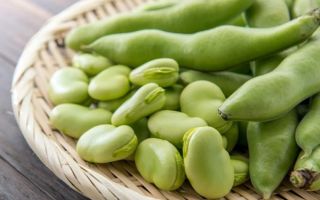Content
- 1 What are beans
- 2 The chemical composition and calorie content of beans
- 3 Useful and medicinal properties of beans
- 4 The use of beans in traditional medicine
- 5 The benefits of sprouted beans
- 6 The benefits and harms of fried beans with salt
- 7 How to cook beans and what they go with
- 8 The harm of beans and contraindications
- 9 Collecting and storing beans
- 10 What is the difference between beans and beans
- 11 Conclusion
Only meat can compare with this culture in terms of protein content: both vegetarians and bodybuilders know about this. However, not everyone knows that beans are not only a family, but also a separate useful plant. The benefits and harms of beans is a topic that, according to its popularity, undeservedly gives way to more popular types of the family - beans, lentils, peas.
What are beans
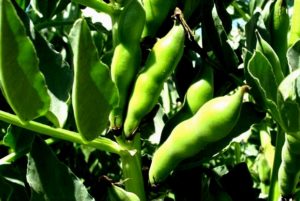
The common bean, or Vicia Faba, is a plant of the legume family, which originates from North Africa and Southwest Asia. Its useful cultivation began as early as the Stone Age, and then the culture spread in Ancient Egypt and Ancient Greece, and in the Middle Ages came to Europe.
Bob is the most typical representative of the family of the same name, which numbers about 17 thousand species. Its fruits are most similar in properties to beans. This is a herbaceous plant with an erect stem, growing in height from 20 to 180 cm. The stem practically does not branch, forming several additional shoots in the lower part. And the root system penetrates into the ground by 1.5 m.
The leaves are blue-green in color, they are unpaired and paired, rather large, fleshy with pointed ends. At the beginning of summer, inflorescences form in their sinuses, consisting on average of 6 pieces of "moth" white, cream and pink flowers containing nectar, which tends to attract insects. At the end of summer, fruits ripen - bivalve beans with an average length of 15 cm, containing 4 - 5 flat irregularly shaped seeds inside, which, ripening up to 7-8 cm long, acquire rigidity and change their shape to oval: convex or flat. The color of the seeds is very diverse.
This is a light-loving plant, unpretentious to soils (except for strongly acidic soils) and to weather conditions, has the properties of good fruit and does not require special care.
By symbiosis with nitrogen-fixing bacteria developing in its root system, it benefits the soil by enriching it with nitrogen.
Black Russian beans
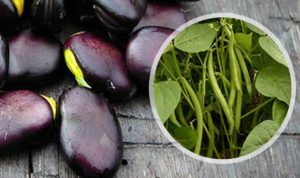
One of the most original types of beans is Russian black. They differ in good aesthetic and taste properties: the latter, unfortunately, are undeservedly forgotten. In Russia, the benefits of black beans were well known even before the baptism of Russia: thanks to the valuable protein in the composition, the fruits not only occupied an important place in the daily diet of people, but were even included in the strategic reserve.
The plant is characterized by branching and reaches a height of 110 cm, usually gives two shoots, each of which forms from 6 to 16 fruits. Externally, the pods are wrinkled, curved, do not need peeling and do not have a pigment layer - therefore they are boiled and canned.The color of the grains themselves is dark purple, from a distance it looks really black.
The plant produces a harvest in 2 months. A sign of maturity is the blackening of the lower pods of the plant.
It is a valuable food product that also contains a large amount of protein. It tastes slightly inferior to ordinary beans, but harmonizes well in dressings for soups and pates. Rye bread made from a mixture of rye flour and black beans has beneficial properties.
Horse beans
Widely known for its beneficial properties in folk medicine, the horse bean is characterized by a more powerful bush and a strong, well-developed root system, an erect stem up to 2 m tall, large, fleshy, pair-pinned, blue-green leaves and brushes containing 10 flowers each.
The pod reaches 10 cm and forms oval seeds of red, brown, black, purple color. Flowering lasts during June-July, and in late summer is harvested. The plant is mainly used for animal feed; it is traditionally eaten in America as a fried snack with salt.
In folk recipes, the plant is used with benefit as a remedy with anti-inflammatory and astringent properties. For cooking, the grains are boiled in milk and then ground into a gruel. Used to accelerate the maturation of boils and abscesses, to cleanse the skin from vitiligo.
The fruits also have high beneficial properties in the treatment of diabetes.
To do this, prepare a decoction of 5-10 beans, which are fried, finely ground and brewed like regular coffee. Drink 1 coffee cup after meals. The broth is also useful for uterine fibroids.
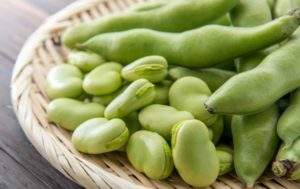
The chemical composition and calorie content of beans
The calorie content of 100 g of beans is 56.8 kcal. This is an average indicator, which is associated with the high content of proteins and carbohydrates in the product. The ratio of BJU (per 100 g of product) based on the average daily requirement of nutrients:
- proteins - 6 g (7.32%);
- fat - 0.1 g (15%);
- carbohydrates - 8.5 g (6.64%).
The product contains 0.5% dietary fiber and fiber; water - 3.24%.
The fruits contain organic acids and sugars, among which starch accounts for the largest share. The composition is enriched with useful components:
- Amino acids - help in tissue regeneration;
- Vitamin A - improves immunity and vision, and also has properties to stimulate cell growth;
- B vitamins - speed up metabolism;
- Vitamin C - helps to enhance the properties of immunity and neutralize viruses;
- Calcium - help to strengthen bones and nails;
- Carotene - has antioxidant properties;
- Cellulose - helps to remove harmful decay products and reduce excess weight;
- Lysine - participates in the normalization of the nervous system;
- Iron and Nicotinic Acid - help to improve blood circulation;
- Pectins - have properties to reduce blood glucose;
- Enzymes - act as catalysts for chemical reactions in the body.
The presence of vitamin B9 or folic acid in the plant plays an important role, the beneficial properties of which are associated with metabolic processes.
Useful and medicinal properties of beans
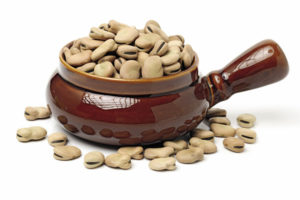
- Especially important is the presence of useful essential amino acids in beans, which are not synthesized by the body, but are well absorbed and go to build proteins - the main "building blocks" for body cells.
- Grains also have beneficial choleretic properties and the ability to remove "bad" cholesterol.
- The beneficial properties of the product also relate to the normalization of blood sugar due to the molybdenum in their composition, in connection with which the beans are used in the dietary menu for diabetes mellitus.
- Molybdenum is also part of the enzymes that remove preservatives that enter the body from industrial products. Fiber and pectins in the plant also have the ability to remove harmful toxins and heavy metals from the digestive tract, which brings prophylactic benefits in ecologically hazardous regions.
- The beneficial properties of beans are manifested in anti-inflammatory, astringent and diuretic effects, which are successfully used in medicine.
- Grains boiled in milk have an antiseptic effect, due to which they are used in the form of puree to "pull out" purulent formations: boils and abscesses.
- The B vitamins in beans have nourishing properties in maintaining healthy skin and nails, slowing aging, preventing wrinkles and strengthening hair.
- With the help of fiber and slow carbohydrates, beans are involved in the formation of short-chain fatty acids, work as a source of energy and influence the improvement of attention, memory, and overall performance of the body.
A useful product is also involved:
- in maintaining normal hormonal levels;
- in the prevention of scurvy and vitamin deficiency;
- for the treatment of trophic ulcers and dropsy.
Some properties of the product are described in more detail below.
With oncological diseases
The fiber and anticarcinogenic substances in beans have anti-tumor properties.
The natural component inositol pentakisphosphate in their composition has the useful ability to inhibit the growth of cancer cells. Experiments on mice made it possible to conclude that the substance manifests itself well in expanding the spectrum of influence of other drugs, according to its properties, it is non-toxic, working well with chemotherapy with minimizing the harm of consequences for the body.
Beans Reduce the Risk of Harmful Breast and Pancreatic Cancer
For the gastrointestinal tract
In terms of composition, the beans are ideal for dietary and vegetarian food, in particular, for the category of people who suffer from liver, kidney and gastrointestinal tract pathologies.
And the astringent and anti-inflammatory properties of the plant are used in the prevention of gastrointestinal diseases.
Useful properties of the product can affect the functioning of the digestive tract:
- in enhancing intestinal peristalsis, stimulating the elimination of harmful decay products - thanks to fiber;
- in the elimination of inflammatory processes in the kidneys, liver and gastrointestinal tract - when used in grated and boiled form;
- in getting rid of diarrheal phenomena - use the astringent property of beans.
For heart and blood
Beans, if consumed regularly, can reduce the level of "bad" low-density cholesterol in the blood: for example, the properties of a bean diet have been proven to reduce blood cholesterol levels by 15% within a week. - as a result of withdrawal in combination with molybdenum.
Due to the beneficial properties of potassium to regulate the heart rate and the constancy of the internal environment of the body, beans help stabilize the work of the cardiovascular system, strengthen the blood vessels.
Slimming
The unique vegetable protein of beans is a complete replacement for animal protein. This benefit is used by vegetarians and dieters.
When it enters the gastrointestinal tract, the bean has the property of enveloping the walls of the stomach, creating a kind of film that separates the lump of food from the mucous membrane. This effect makes absorption difficult: it helps to maintain a feeling of satiety with a low calorie content of the product, which, together with a high nutritional value of protein, a useful vitamin and mineral composition,cleansing properties with benefits for the body is used in dietary meals based on beans for weight loss.
When losing weight, the main focus is on the benefits of burning fat. But in order to help the body to get rid of the usual excess weight without stress, it must be provided with a useful protein component of the diet. Proteins are part of muscle tissue and are not burned in a diet that breaks down fats.
The benefits of beans for weight loss are manifested in facilitating the tolerance of diets, which is ensured by the composition and properties of the product: 100 - 150 g of grains allow you to saturate the body with useful plant proteins that can compete with meat in properties. A delicate and satiating bean diet is a good option for weight loss.
The use of beans in traditional medicine
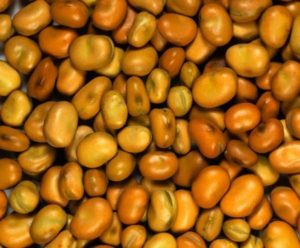
The medicinal properties of the plant are recognized in official and folk medicine, where they are usefully used to treat vitamin deficiency, diabetes, obesity, and dystrophy. Strenuous exercise and kidney and liver disease also make the list of indications for beans.
The anti-inflammatory properties of beans are used to relieve inflammation and accelerate the healing of wounds on the skin: for this purpose, the beans are boiled in milk and crushed in a puree, which is applied to abscesses and boils.
Cooked and mashed beans, as well as their decoctions, due to the beneficial diuretic, astringent and anti-inflammatory effect, are used for inflammation of the gastrointestinal tract, accompanied by loosening of the stool.
Useful decoctions and infusions are prepared on the basis of the product:
- 2 tbsp. l. bean grains pour 2 tbsp. boiled water and cook in a water bath for 10 minutes. When the composition has cooled, it is divided into equal portions and taken up to 4 times a day. The tool has a prophylactic effect on stomach diseases.
- Dry seeds are crushed into bean flour, which is heated and applied to abscesses, wounds. Its properties are also used for other skin problems.
- Prepare a decoction of leaves and stems, pouring 200 ml of hot water over a handful of raw materials, simmer in a water bath for up to 10 minutes. Used as compresses in the treatment of thrombophlebitis.
- 1 tbsp. l. beans are poured into 400 ml of boiled milk. Cook over low heat for up to 30 minutes and let it brew. The soft seeds are ground and applied in the form of a compress to wounds and abscesses, helping them to heal.
- Pour 50 g of dried flowers into ½ l of boiling water, leave for 2 hours, and then filter the composition. The broth is used with benefit for washing due to its properties to improve the structure of the epidermis and skin color.
The benefits of sprouted beans
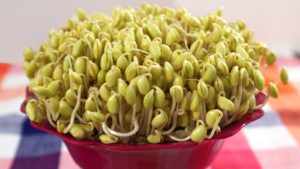
During germination, all the original useful components of the beans pass into a concentrated and easily digestible form. It turns out a kind of "cocktail" of vitamins, minerals, amino acids, enzymes.
During germination, legume grains have the ability to break down complex substances into simpler and more accessible to the body. The benefits of bean sprouts are manifested in a 90% decrease in the load on the gastrointestinal tract when they are consumed in comparison with non-sprouted grains: during the sprouting of the sprouts, useful enzymes are prepared in advance and compounds are broken down, which facilitate the digestion process.
In naturopathy, it is customary to distinguish 3 types of products:
- Bioenergetic: thermally processed food, in which mineral salts, amino acids and carbohydrates with fats remain.
- Bioactive: dry, frozen or fresh food, in which only part of the beneficial vitamins and enzymes remains.
- Biogenic: biologically active by properties, in which the content of vitamins and enzymes is at the maximum. These include seedlings.
The use of sprouted beans consists in their biogenicity (living state), due to which they acquire the properties of biological activity and thus share not only their useful composition, but vital energy.
It is also known that biogenic seeds of sprouted beans lose their unique benefits during prolonged germination, which can make them empty and even capable of causing harm: therefore, it is recommended to use grains with sprouted sprouts up to 0.5 cm.
The benefits and harms of fried beans with salt
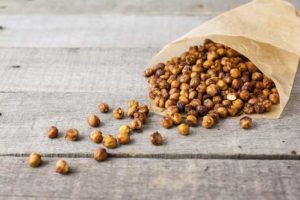
The analogue of salted peanuts, popular with our consumers, in America is a snack made from fried beans with salt.
To prepare such a product, salt, soda, vegetable oil are used as ingredients. And the finished product from the supermarket also contains monosodium glutamate, palm oil, modified corn starch, and flavorings. Such a list speaks more about the dangers of beans with salt than about the benefits of the product.
Beans with salt are high in calories: 407 kcal per 100 g of product.
The beneficial properties are very doubtful, and the harm to the figure and health is obvious. One 250 g serving of the product "gives" the body 1017 kcal - half of the recommended daily allowance. You can forget about the dietary properties of such a dish, especially since the process of frying the product itself introduces carcinogens into the composition, the harm of which in provoking the growth of cancer cells is known to everyone.
How to cook beans and what they go with
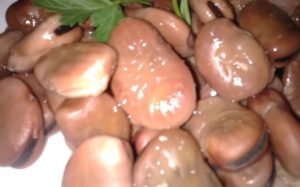
Legumes have the ability to produce protein and are undoubtedly beneficial in the diet. This applies not only to vegetarians and vegans who eat exclusively plant proteins, but is also of undoubted interest for lovers of quality food. The healthiest dishes are known to be the easiest to prepare.
Bean salad
Required:
- beans - 0.5 kg;
- cheese - 150 g;
- bell pepper - 1 pc .;
- garlic - 3 cloves;
- mayonnaise.
Cooking steps:
- The beans are boiled.
- The cheese is cut into small cubes.
- Pepper is washed and peeled from seeds, cut.
- Garlic is squeezed out with a press and added to the salad.
- All are dressed with mayonnaise.
Bean puree

Mashed potatoes are easy to prepare, and the result is a delicious garnish with a healthy protein composition. To do this, 200 g of beans are washed and soaked in cold water. Leave overnight to swell, and in the morning boil for 2 - 3 hours until soft. Rub through a sieve and add salt, oil, pepper to taste. Serve warm. The output is 4 servings.
The harm of beans and contraindications
The main disadvantage of beans is their high gas-forming property, which can manifest itself even in people with a healthy digestive tract. Such harm can provoke overuse or improper preparation of the product.
Despite the entire arsenal of useful properties, beans can behave aggressively towards the digestive tract. This is due to the presence in their composition of oligosaccharides that cause fermentation and flatulence, as well as toxic phytohemagglutinin, which can cause poisoning. In the composition of legumes, the presence of trypsin inhibitors has been proven - a group of substances that block enzymes that digest proteins. The properties of these poisons are in their ability to provoke problems with the pancreas, as well as harm to cancer, polycystic and pancreatitis.
Basic safety rules when processing beans:
- When germinating, it is necessary to change the water up to 3 times - in the drained liquid and all the poisons will remain. It is also advisable to use this rule when soaking.
- Germination for more than 4 days reduces the amount of toxins by up to 4 times.
- Soaked beans should be boiled for at least 1.5 hours, and sprouted grains (within 3 to 4 days) are cooked faster - until softened.
Contraindications to the use of the product are:
- insufficient soaking and heat treatment;
- the use of the product in children (under 2 years of age is strictly prohibited) and in old age (it is recommended to use small portions).
As well as chronic diseases:
- gout;
- nephritis;
- thrombophlebitis;
- hepatitis;
- inflammation of the gallbladder.
Collecting and storing beans

Rules for storing beans grown independently:
- After harvesting, the beans should be sorted out, removing the damaged fruit.
- Freshly harvested beans are stored in the refrigerator for a short time, up to 3 days, and then they are thermally processed.
- Grains in pods can be kept in the refrigerator for up to 7 days, but it is best to remove them from the pods just before cooking.
- Before removing the fruits from the collected pods, they are hung in ventilated places to dry and remove excess moisture.
- For freezing, the beans are pre-blanched and dried well with a paper towel. The shelf life will be up to six months.
- Beans are dried for up to 15 minutes in preheated to 50aboutWith oven.
- The dried beans will preserve the beneficial properties in natural cloth bags or in tightly closed containers. Shelf life - up to a year, with regular checks for damage.
Storage rules for beans bought in the store:
- With intact sealed packaging, beans (including canned ones) are stored in accordance with the period indicated on the package, during which the product does not lose its usefulness.
- When the package is opened, the grains are transferred into containers, which are closed with lids.
- The storage place should be dry, shaded, not warm: usually lockers.
- Long-term stored beans should be regularly checked for damage from plaque, bugs, damage.
What is the difference between beans and beans
Beans and beans are from the same legume family, and the confusion is mainly related to the name.
The differences are related to the origin, botanical features and properties:
- cultures have different origins: beans are native to the Mediterranean, and beans came to us from Latin America;
- beans grow as bushes and beans are a climbing plant;
- the seeds of the beans are irregular in shape, the beans are aligned and the same;
- in beans, in addition to fruits and valves, flowers also have medicinal properties, while the color of the beans was not used in herbalist recipes;
- the nutritional properties of the two crops for the most part converge, including with respect to the culinary processing of grains.
Conclusion
If we put on the scales the benefits and harms of beans for human health, then the undoubted preponderance will be in the direction of the value of these fruits for health. Taking into account the contraindications, this is an excellent source of natural protein and building material for the body, which in the age of refined products is a great deficit.

